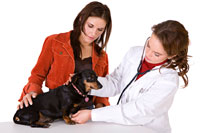
While we all wish our precious pets were perfect little citizens, this is not always the case. There are all types of behavior problems, and the solutions can often be challenging. At Buckeye Veterinary Clinic we are here to help, or help you find someone who can help your pet. Below are examples of types of behavior problems.
Aggression
Aggression can be triggered by a number of things, but an aggressive pet has the potential of putting you and your family and friends at risk.
- Fear Aggression: This is probably one of the most common forms of aggression. We are not able to talk to our pets and make them understand and our pets cannot always communicate what is making them afraid. When a pet is placed in a situation that scares them, sometimes they feel the only way to react is with aggression.
- Inter-Animal Aggression: This is an aggression problem where one pet attacks, or tries to attack, other animals.
- Food/Toy Aggression: This form of aggression occurs because the pet is possessive of their food or favorite toy.
Anxiety
This is another way fear can be demonstrated by your pet. Anxiety can lead to destructive behaviors in the home and poor quality of life for the pet.
- Separation Anxiety: This happens when a pet is left alone or separated from the members of their family. Some of the common signs are: destruction (especially near the door the person/people leave and return by), excessive vocalization when the owners leave, excessive greetings upon the family’s return and inappropriate soiling.
- Thunderstorm/Firework Anxiety: Just like small children, pets can sometimes be terrified of loud noises like thunder or fireworks. This can be seen by the pet hiding, soiling, vocalizing, or even being aggressive during these events.
- Inappropriate Elimination: This is when a normally well housebroken pet suddenly starts urinating or defecating outside the normal places (i.e.- inside the house or outside the litter box). This problem can be medical (i.e.- a urinary tract infection), environmental (i.e.-a poor litter box environment) or behavioral.
These are just a few examples of behavioral problems. The veterinary staff at Buckeye Veterinary Clinic can begin the process of determining and treating, if necessary, if the problem is due to a medical condition or is a psychological or environmental problem. Some behavioral problems cannot be fixed with a shot or a pill, but will require time and effort. We are fortunate in northeast Ohio to have resources with specialized training to help owners help their pets.
Links & Resources
The Behavior Clinic – Dr. Elizabeth Feltes
Keystone Veterinary Clinic – Dr. Eileen Savier, CVA, CVCH
All Dogs Go To Kevin – Kevin, CPDT-KA & Kelly, CTC
Woof Wise Dog Training – Chris Lantzer, CPDT-KA





